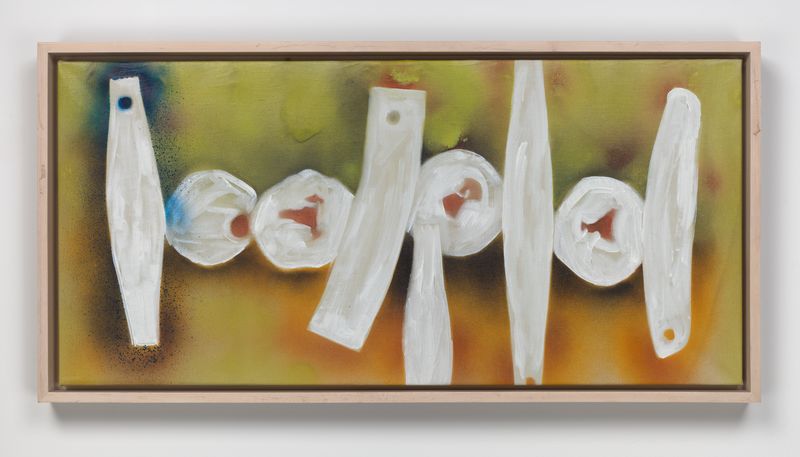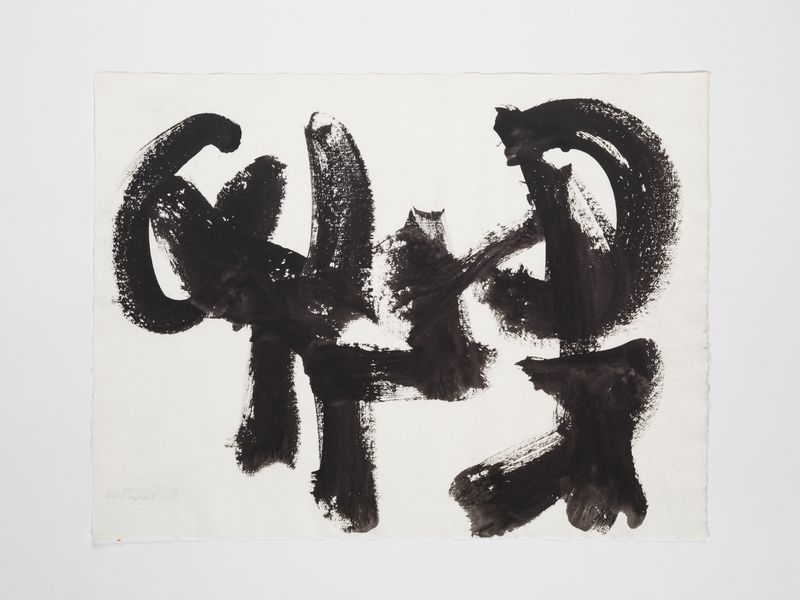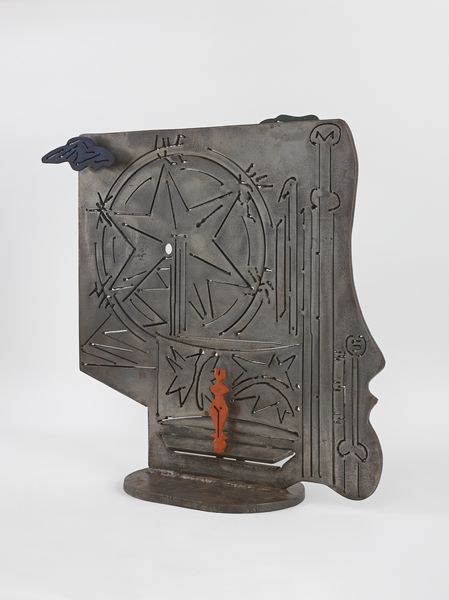
David Smith, Rebecca Circle, 1961 © 2019 The Estate Of David Smith / Licensed By Vaga At Artists Rights Society (Ars), Ny. Photo: Jerry L Thompson
Teachers’ Notes: ‘David Smith. Field Work’
This resource has been produced to accompany the exhibition, ‘David Smith Field Work’ at Hauser & Wirth Somerset from 28 September 2019 until 5 January 2020.
‘We are thrilled to see our late father’s work in Somerset, the rural setting is reminiscent of the rolling hay fields around his studio. He wanted his sculptures to be experienced in nature, in changing light, weather and seasons. In the morning he walked down the driveway to the ‘shop’ which is what he called his studio; at night he worked on drawings in the house. From our bedroom my sister and I would hear the particular rattle of his spray cans as he made drawings to jazz records. I see in these works a great sense of what I knew of my father – his love of making and constructing form’ – Rebecca Smith, June 2019
About David Smith
David Smith was born in 1906 in Decatur, Indiana in the USA. He died in 1965 in Vermont aged 59 years old. Smith is regarded as one of the most influential and innovative sculptors of the twentieth century. Closely linked to the Abstract Expressionist movement, David Smith is known for his use of industrial methods and materials, and the integration of open space into sculpture. Smith worked as an automobile welder and riveter before moving to New York to study at the Art Students League. In 1929 he bought a farm in Bolton Landing, in the Adirondack Mountains of upstate New York – an idyllic location where he would settle permanently in 1940 and with which he would be forever associated. This exhibition has been conceived as four chapters of work spanning over three decades (from 1933 to 1964) that aim to demonstrate Smith’s diverse visual language and multifaceted creative process.
Curated by the artist’s daughters Rebecca and Candida Smith, co-presidents of the David Smith Estate, the exhibition situates itself between the drawn image and sculpted form to investigate the relationship between the two parallel practices. Exhibitions devoted to David Smith’s sculptures, paintings, and drawings have been presented internationally since the 1950s. Smith represented the United States at the Sao Paulo Biennale in 1951, and at La Biennale di Venezia in 1954 and 1958. The Museum of Modern Art presented his first retrospective in 1957. His work was included in Documenta II in 1951 and 1959, and Documenta III in 1964.
In 1962, at the invitation of Giovanni Carandente and the Italian government, Smith went to Voltri, near Genoa, Italy, and executed 27 sculptures for the Spoleto Festival. Dozens of Smith retrospectives have been mounted in the decades since, including shows at Guggenheim Museum, New York NY (1969); National Gallery of Art, Washington DC (1982); Sezon Museum of Art, Tokyo, Japan (1994); MNCA, Reina Sofia, Madrid, Spain (1996); The Metropolitan Museum of Art, New York NY (2000); Tate Modern, London, England (2006); and Storm King Art Center, Mountainville, NY (2017). A survey of sculpture by David Smith is on display at the Yorkshire Sculpture Park from 21 June 2019 to 5 January 2020.

David Smith, Untitled (Study For Agricola I), 1951© The Estate Of David Smith. Photo: Damian Griffiths
What does his work look like?
David Smith is best known for creating large steel abstract geometric sculptures. During the 1930s Smith was constructing compositions from steel and ‘found’ scrap such as parts of agricultural machinery and abandoned farm implements. His sculpture during the 1940s and 1950s was open and linear, like a ‘drawing in space’. From the end of the 1950s up to his death he created more structured and massive work for which he is best known, often working in series such as ‘Zig’, ‘Tanktotem’, ‘Agricola’, ‘Cubi’, and, ‘Voltri’. Included in this exhibition are also bronze reliefs from the 1950s in which the picture plane has been pushed out into the third dimension as well as ink drawings, spray paintings and spray drawings.
What inspires his work?
Smith maintained that there was no essential difference between painting and sculpture and that although he owed his ‘technical liberation’ to Julio Gonzalez, (he came across the welded sculptures of Gonzalez and Picasso in the magazine, Cahiers d’Art) his aesthetic outlook was more influenced by Kandinsky, Mondrian and Cubism. Smith was born in 1906 at a time when the world was in flux between agrarian and industrial life. His grandfather had been a blacksmith and his father became a telephone engineer and a part time inventor.
The merging of nature and industry was part of his upbringing; as a child he played in fields and railroads near his home but in his teenage years he saw the effects of the post war economic boom with the establishment of large metal working factories. Having worked and lived in New York City, in 1940 Smith moved permanently to Bolton Landing which was a small isolated town above Lake George in the Adirondack Mountains several hours drive north of New York City. This agrarian landscape gave him materials for his sculpture (tractor parts, agricultural equipment) but also became a subject for his work. The natural landscape was a backdrop for his photographs and the site for showing his sculptures.

David Smith, Untitled, 1964 © The Estate Of David Smith. Photo: Genevieve Hanson
What are the main themes?
Industrial Materials and Techniques
Challenging sculptural conventions, Smith was the first artist in America to work with welded metal, and became known for his mastery of steel. Smith even named his early rural New York State studio ‘Terminal Iron Works’ after the Brooklyn welding shop where he learned so much.
The Land
Smith found a great fascination in the aesthetics of the land and the relationship between mankind and the earth. Included in the exhibition is a selection of works from the artist’s Agricola series made during the early 1950s. These joyous, almost folkloric forms were imbued with childhood memories of growing up in the Midwest and his life in Bolton Landing. Taking the Greek word Agricola as its title, this body of work is both of the land and from the land.
Man
During the 1950s the upright ‘figure’ became one of Smith’s dominant themes. Untitled, (Study for Agricola I) (1951) and Untitled (Hanging Sculpture) (1953) both suggest the human figure and these personages reference the iron from the earth and the formation of objects and tools by ancient cultures.
Drawing in Space
Smith’s major contribution to art history is often cited as his ability to approach sculpture not in traditional terms of volume and mass but in the possibility of a ‘drawing in space’. In 1952 he wrote, ‘If a sculpture could be a line drawing, then speculate that a line drawing removed from its paper bond and viewed from the side would be a beautiful thing’.
How does he make his sculptures?
Whilst studying painting Smith had begun to incorporate found objects such as shells, bones and wood into his paintings, transforming them into sculptural reliefs. He began experimenting by constructing sculpture rather than carving in stone or casting in bronze. As a student David Smith had spent the summer of 1925 working in Studebaker automobile factory in South Bend, Indiana and learnt the technique of welding. Smith went on to master this technique in the 1930s in a Brooklyn welding shop. Welding is a method of joining together metal parts by heating the surfaces to the point of melting with a blowpipe, electric arc, or other means, and uniting them by pressing or hammering.
He had a large stockpile of various metal elements at Bolton Landing and his later work moved towards constructing from these elements. He would work on numerous pieces at the same time; often laying out various pieces of steel on the floor and changing the composition until the juxtaposition of elements suggested the direction of the final work. This was different to the earlier process of a separate design and subsequent metal fabrication. Smith also used bronze relief to push out the picture plane into the third dimension. Inspired by Sumerian seals and Greek coins the reliefs suggest undefined crows of figures that predicted the lines of sculptures that would later parade in the fields of Bolton Landing.
How does he consider his drawings?
David Smith drew regularly throughout his career for many different reasons: to make notes, plan sculptures, jot down observations, explore techniques, relax, and make works of art. Smith drew every day and his sketchbooks reveal that he had various sources of inspiration: stuffed animals, country landscapes, hieroglyphs, medical book illustrations, nudes, newspaper stories, machinery and classical philosophy. Smith was influenced by the writings of John Cage and Martha Graham’s dance company; a set of drawings in this exhibition are imbued with a sense of motion, dance and jazz. For Smith drawing was often produced in parallel to sculpture making. Smith used to switch back and forth as a crucible for thought and innovation. The drawings allowed him to work on smaller scale, more quickly and with greater flexibility in comparison to the laborious and time consuming process of large scale sculpture.

David Smith, Untitled, 1956 © The Estate Of David Smith

David Smith, Untitled, 1960 © The Estate Of David Smith. Photo: Epw Studio
How does he make his drawings?
For his drawings, Smith used a broad variety of media including tempera, gouache, oil, industrial spray enamel, and, increasingly after 1951, one of his own invention: egg-ink made from a mixture of egg-yolk and India ink. One drawing group from the late fifties is made up of lustrous gestures painted with a a brush full of ink. Generous and high in density, they were quick performances, almost primordial in feeling. He would fill the sheet, daubing the ink onto the paper in a childlike manner. With the advent of the aerosol in the mid-1950s Smith found an industrial technique for applying paint that he could make his own.
GLOSSARY
ABSTRACT EXPRESSIONIST MOVEMENT
A term which came into common use from c.1950 to describe a movement in abstract art that developed in New York in the 1940s. The artists (including Willem de Kooning, Jackson Pollock, Philip Guston) shared a similarity of outlook, revolting against traditional styles or procedures with an emphasis on self determination and freedom of expression, rather than a singular style.
ABSTRACTION
This is a term that can in its broadest sense be applied to any art that does not represent recognizable objects but which is most commonly applied to those forms of 20th century art in which the traditional European conception of art as the imitation of nature is abandoned.
AGRARIAN
Relating to cultivated land or the cultivation of land.
CASTING
The act of shaping material by pouring it into a mould while molten.
JOHN CAGE (1912–1992)
American composer, artist and philosopher who was one of the leading figures of the post-war avant-garde.
INDUSTRIAL
Relating to or characterized by industry; the economic activity concerned with the processing of raw materials and manufacture of goods in factories.
MARTHA GRAHAM (1894–1991)
American modern dancer and choreographer. Her style, the Graham technique, reshaped American dance and is still taught worldwide.
JULIO GONZALEZ (1876-1942)
Spanish sculptor who was the leading pioneer in the use of welded iron as a sculptural medium. His work had great influence, notably on Picasso, to whom he taught the techniques of iron sculpture.
SCULPTURE
A three dimensional art made by one of the four basic processes: carving, modelling, casting and constructing.
STEEL
Steel is a metal that is most often used in industry. It has been used for over 3,500 years, and is one of the most widely used materials in the world today – from hairpins and cutlery, to large buildings and bridges. Steel is long lasting, able to be shaped, bent, stretched and squeezed.

David Smith, Steel Drawing Ii, 1945 © The Estate Of David Smith. Photo: Genevieve Hanson
TEMPERA
A method of painting with pigments dispersed in an emulsion miscible with water, typically egg yolk.
WELDING
A method of joining materials in which heat is supplied either electrically or by means of a torch.
Suggested discussion questions for your visit:
• Why do you think David Smith chose to work in steel?
• What steel objects do you have in your home?
• How would David Smith’s sculptures change if he had chosen traditional sculpting materials like marble, plaster, or wood?
• Imagine his sculpture made out of temporary materials like ice, chocolate or even mud. How might this change their shape? David Smith worked in factories and made parts for cars on an assembly line.
• How has he used the skills from this job in the making of his sculpture?
• See if you can spot these skills in any of his sculptures. Discuss with your group to see whether they agree. Choose a sculpture that really intrigues you. Spend some time looking and thinking about it.
• How solid is the sculpture? How has the artist made it balance and stand?
• How has the artist used space between the materials to create shapes?
• Notice the surface texture. How has he created marks?
• David Smith trained as a painter. How has he used this skill?
• What do you find that is surprising?
• How does the sculpture change as you move? Which position do you find most interesting?
• How do you think David Smith’s sculptures are best viewed? From one spot or walking around? David Smith wanted his work to be shown outside. He often arranged his sculptures in rows like crops in the fields outside his house.
• Look outside at his work. How does the work change when it is outside?
• Do you prefer looking at his sculpture in the gallery or outside? Why?
Related artists: Arshile Gorky Anthony Caro Eduardo Chillida Julio Gonzalez Monika Sosnowska Henry Moore
NB. You will need to bring pencils and a sketchbook.
Activity 1
Steel is a stubborn material. David Smith has created sculpture that is delicate as well as strong. Choose a sculpture that has graceful shapes. Use your finger in the air to follow these lines and shapes. Now draw: challenge yourself to keep your pencil on the paper and do a continuous line drawing.
Activity 2
Think about how David Smith used steel to create shapes. Draw your own graceful flowing sculpture. Challenge yourself to use the hand you don’t normally use. What do you notice?
Activity 3
Think about how your marks can create lightness, weight, space and air. With your pencil, press hard and soft then move slowly and quickly.
Activity 4
Look for and find spaces in the sculptures that you can see through. Draw these spaces. Create new sculptures that are inspired by these shapes.
Activity 5
Towards the end of David Smith’s life, he was making sculptures in large scale. Choose an artwork that you think is very large. Make a drawing of a section of the artwork. Look carefully to capture detail.
Activity 6
Look closely at three different sculptures. Pick your favourite. What surfaces and patterns do you see? Are they smooth, rough or shiny? Work with someone in your group to draw the different textures you can see. Experiment with your pencils to see how many different types of marks you can create together.
Activity 7
Now you have studied some sculptures: Shut your eyes and draw a sculpture from memory. What do you notice? With your eyes open, fill your page with colours to add pattern and texture.

David Smith, Untitled, 1958–1959 © The Estate Of David Smith. Photo: Christopher Burke Studio
Practical activity following your visit:
Look at the sculpture titled ‘Hudson River Landscape’. David Smith often travelled alongside the Hudson river and looked at the landscape.
• Draw a journey you often take. Be inspired by David Smith and draw the things that interest you rather than copying what you see.
• If you were to make your drawing into a sculpture what material would you use? Why?
• How would your sculpture change if it was made out of a different material? Try creating the drawing using wire.
Supplementary research:
David Smith David Smith: Sculpture 1932–1965 as part of Yorkshire Sculpture International David Smith: Form in Colour, Hauser & Wirth Publishers, 2016 David Smith: Sculpture and Writing, Cleve Gray (ed), London: Thames and Hudson, 1989 David Smith, Collected Writings, Lectures and Interviews, Susan Cooke (ed), University of California Press, 2018.
Resources
1 / 8









